Vincent van Gogh celebrated for his remarkable landscape paintings, established himself as a renowned artist through his mastery of this genre.
Vincent Van Gogh’s devotion to landscape art was driven by many factors, making each iconic work a lasting testament to his artistic brilliance. In this exploration, we’ll delve into 24 of his most beloved landscapes and unravel the significance that continues to captivate audiences today.
Table of Contents
- Vincent Van Gogh’s Landscape – 24 Masterpieces: A Journey Through Nature And Emotion
- 24 Vincent Van Gogh Landscape Paintings
- The Starry Night (1889)
- Mountain Landscape behind the Saint Paul Hospital (1889)
- Starry Night Over the Rhône (1888)
- The Olive Trees (1889)
- The Harvest (1888)
- The Red Vineyard (1888)
- The Yellow House (1888)
- Green Wheat Field with Cypress (1889)
- Wheatfield with Crows (1890)
- Wheat Field with Cypresses (1889)
- View of Arles, Flowering Orchards (1889)
- Olive Trees with Yellow Sky and Sun (1889)
- Farmhouse in Provence (1888)
- The Poet’s Garden (1888)
- Entrance to the Public Gardens in Arles (1888)
- Wheat Stacks with Reaper (1888)
- Willows at Sunset (1888)
- The Langlois Bridge at Arles (1888)
- The Church at Auvers (1890)
- A Meadow in the Mountains: Le Mas de Saint-Paul (1889)
- Woman Walking Under the Trees (L’Oliver) (1889)
- Olive Grove (1889)
- The Road Menders (1889)
- View of Paris from Montmartre (1886)
- Related Questions
Vincent Van Gogh’s Landscape – 24 Masterpieces: A Journey Through Nature And Emotion
Vincent van Gogh, the Dutch Post-Impressionist painter, is renowned for his emotional and expressive artworks that delve deep into the human psyche. While he’s celebrated for his vibrant portraits and intimate self-portraits, his landscape paintings are equally significant, showcasing his unique approach to nature and art.
Read on as we explore why Van Gogh painted landscapes and delve into the importance and significance of some of his most famous landscape masterpieces.
The Emotional Connection With Nature
Vincent van Gogh had a profound connection with nature, and this connection was a driving force behind his landscape paintings. His tumultuous life, marked by struggles with mental health and a relentless pursuit of artistic excellence, found solace in the serenity of the natural world.
Van Gogh saw nature as a mirror reflecting his inner emotions, and his landscapes became a canvas to convey his feelings, moods, and perceptions.
Expression Of Emotion
Van Gogh believed that the natural world was not merely an external subject to be painted but a living entity with its own emotions and vitality. He sought to capture the essence and emotions of nature, often transforming the mundane into the extraordinary through his use of color, texture, and brushwork. Each landscape painting was a reflection of his inner state and a way to communicate his emotional turmoil or joy.
Escape And Healing
Throughout his life, Van Gogh battled mental health issues, including episodes of severe depression and anxiety. Painting landscapes provided him with an escape from his inner demons, offering moments of respite and healing.
Immersing himself outdoors, observing the changing light, and translating these experiences onto canvas gave him a sense of purpose and tranquility.
Connection With The Divine
Van Gogh’s landscapes also held a spiritual dimension. He often saw the divine, describing it as “the eternal and the divine.” In his paintings, he sought to convey not just the physical beauty of the world but its spiritual essence.
This connection with the divine allowed him to create landscapes that were not mere representations of the external world but transcendent expressions of his inner spirituality.
24 Vincent Van Gogh Landscape Paintings
Vincent Van Gogh painted many iconic landscape paintings.
Read on as we delve into some of Vincent van Gogh’s most iconic landscape paintings, exploring their years of creation and why they are considered essential and significant.
The Starry Night (1889)
The Starry Night is one of Van Gogh’s most famous and iconic works. Painted in 1889 during his stay at the Saint-Paul-de-Mausole asylum in Saint-Rémy-de-Provence, France, this masterpiece is an ethereal representation of the night sky. The swirling stars and the glowing moon convey a sense of cosmic wonder.
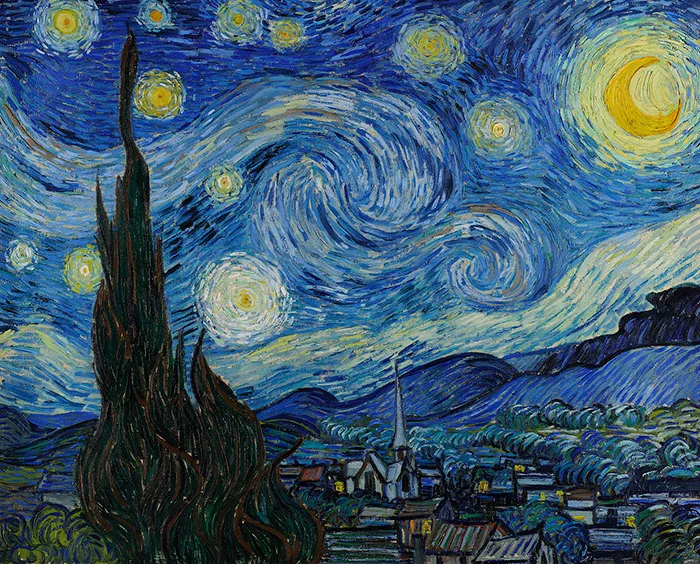
The significance of The Starry Night lies in its ability to evoke a deep emotional response from viewers. Van Gogh’s bold colors and swirling, turbulent brushwork reflect his inner turmoil and longing for solace.
The painting is a testament to his ability to transform the ordinary into the extraordinary, creating a timeless work that continues to captivate and inspire art enthusiasts worldwide.
Mountain Landscape behind the Saint Paul Hospital (1889)
Created during the same period as The Starry Night, Mountain Landscape behind the Saint Paul Hospital is a poignant depiction of the rugged landscape surrounding the asylum where Van Gogh sought treatment for his mental health issues.
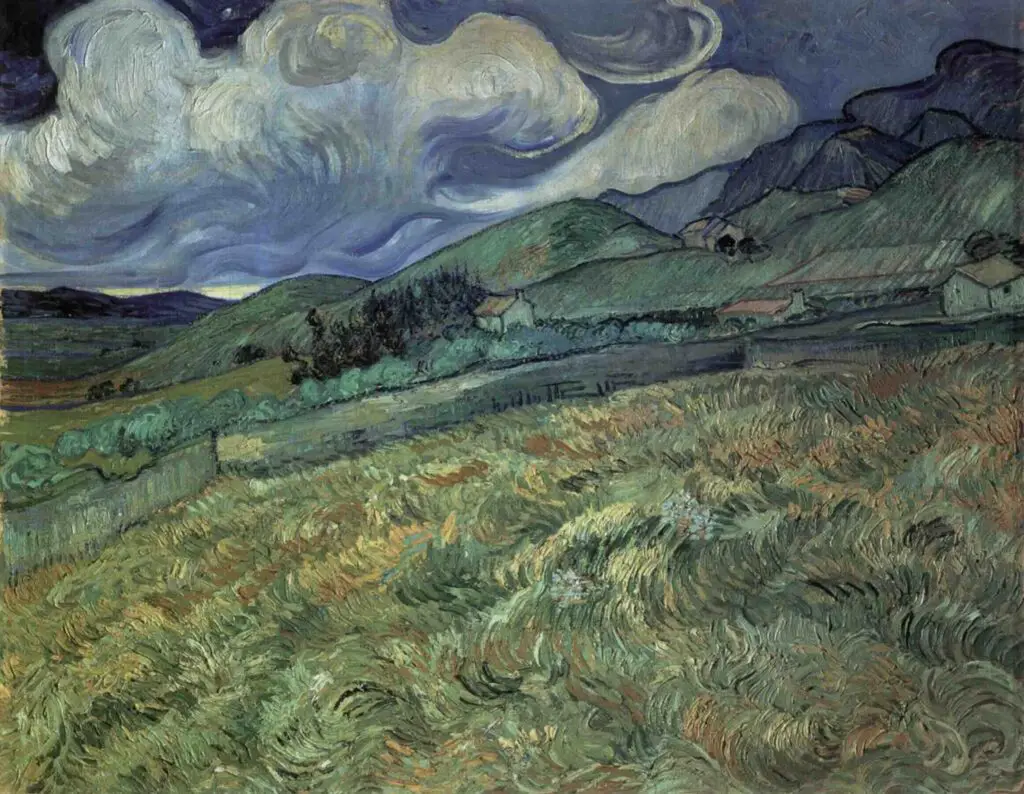
This painting is significant as it reflects his physical and emotional surroundings.
The mountains in the background convey a sense of isolation and confinement, mirroring Van Gogh’s feelings at the hospital. The turbulent brushwork and vivid colors in the foreground symbolize his inner turmoil.
It is a powerful reminder of the artist’s struggle with mental illness and his ability to channel those emotions into his art.
Starry Night Over the Rhône (1888)
Starry Night Over the Rhône, painted in 1888 during Van Gogh’s time in Arles, France, is another masterpiece that explores the nocturnal landscape. Unlike The Starry Night, this painting depicts a serene scene with the Rhône River reflecting the night sky.
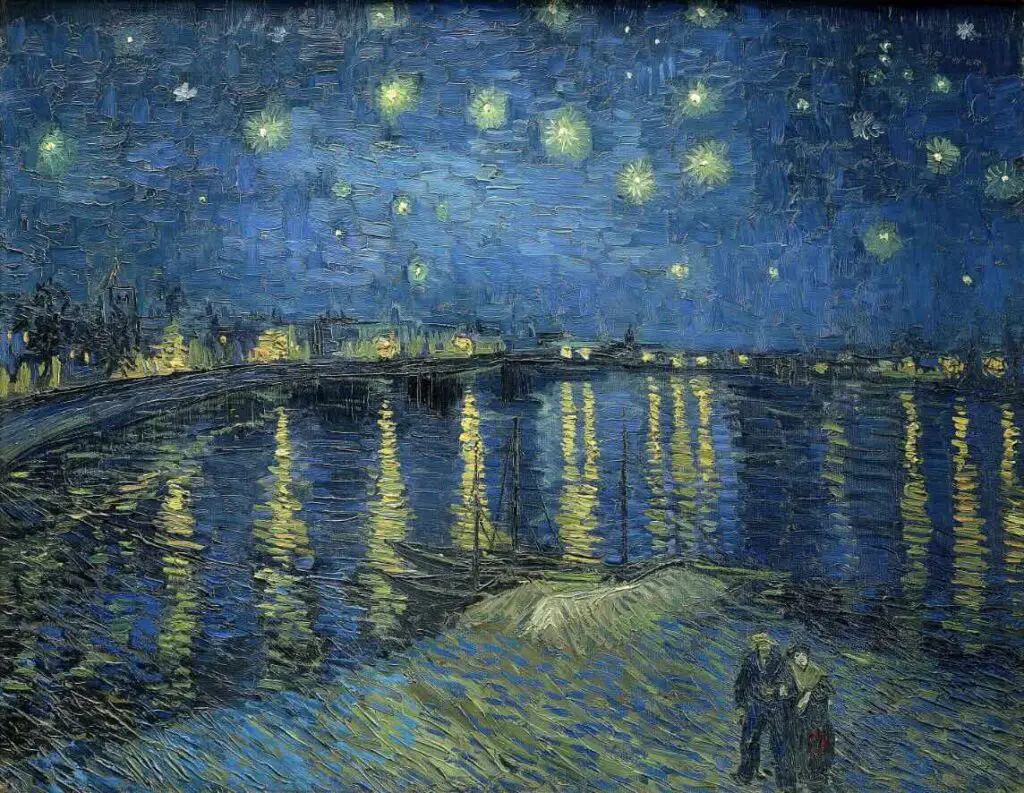
This painting is significant for its contrast with The Starry Night. While it still captures the magic of the night, it does so in a more tranquil and contemplative manner.
Shimmering reflections on the water’s surface and the warm, inviting colors create a sense of peace and harmony. It shows Van Gogh’s versatility in portraying the same subject matter – the night sky – with different emotional nuances.
The Olive Trees (1889)
The Olive Trees series, created in 1889 while Van Gogh was at the Saint-Paul-de-Mausole asylum, is a testament to his deep connection with nature. These paintings depict the olive groves surrounding the asylum, and they are significant for their vibrant colors and intricate brushwork.
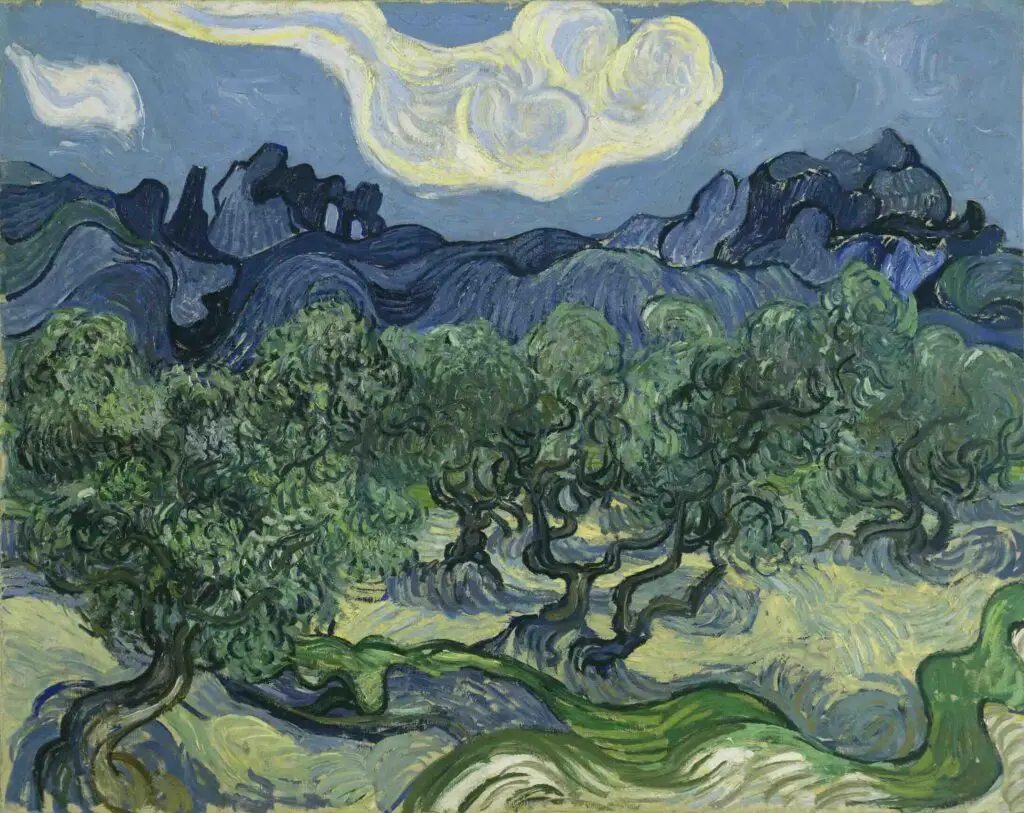
Van Gogh’s choice of olive trees as a subject matter is noteworthy because they held personal symbolism for him. He saw the olive tree as a symbol of perseverance and hope, qualities he struggled to maintain throughout his life.
Through these paintings, he aimed to convey nature’s enduring beauty and vitality, even in adversity.
The Harvest (1888)
Painted in 1888, The Harvest is a vibrant and dynamic portrayal of peasants working in the fields during the harvest season. This painting is significant as it captures the spirit of rural life and the labor of ordinary people, a theme that Van Gogh explored throughout his career.
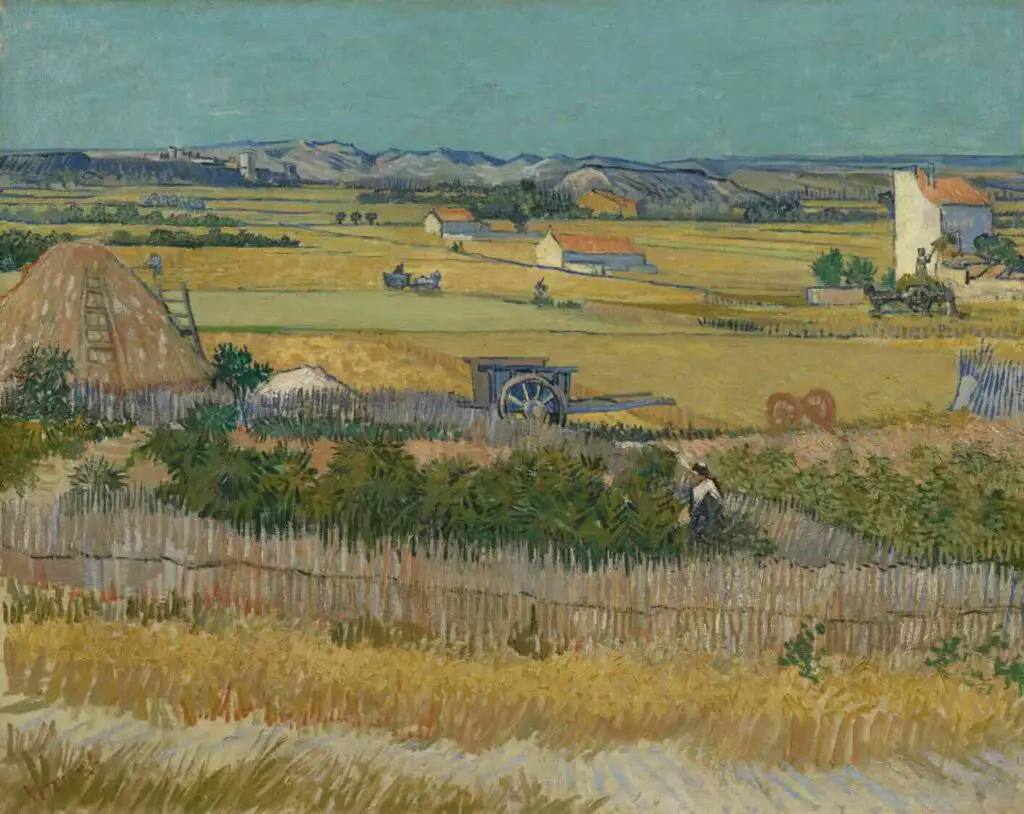
In The Harvest, Van Gogh’s bold colors and vigorous brushwork impart a sense of energy and vitality to the scene. The swirling patterns in the sky and the rhythmic movement of the figures in the field convey a sense of harmony between humanity and nature.
This painting reflects Van Gogh’s admiration for rural workers’ simple, honest lives and his desire to celebrate their contributions.
The Red Vineyard (1888)
The Red Vineyard, painted in 1888, holds a unique place in art history as one of the only paintings sold by Van Gogh during his lifetime. It depicts a vineyard in Arles during the grape harvest, with workers laboring under the bright red vines.
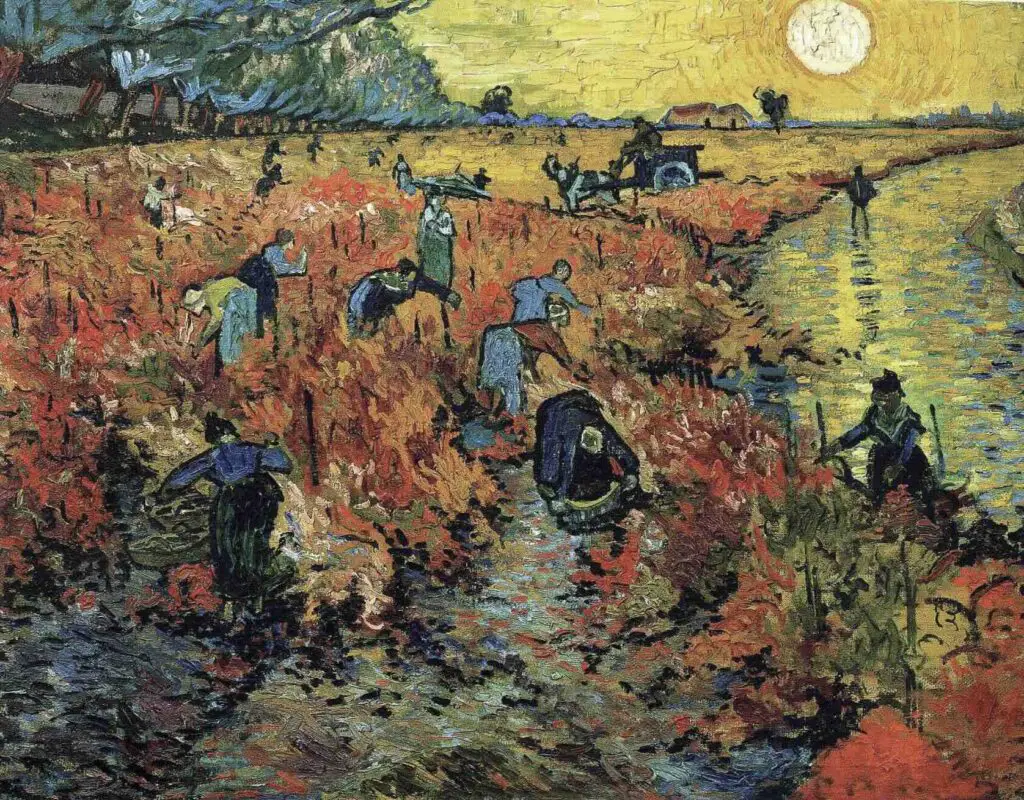
The significance of this painting lies in its historical importance – it represents Van Gogh’s only documented sale during his lifetime. It was purchased by Anna Boch, a Belgian artist and collector who recognized the value of Van Gogh’s work.
The Red Vineyard provides a glimpse into the artist’s fascination with rural life and vivid colors and serves as a testament to his growing recognition.
The Yellow House (1888)
The Yellow House, painted in 1888, depicts the house in Arles where Van Gogh lived for some time. The bright yellow facade and the blue sky create a striking contrast and capture the essence of the Mediterranean.
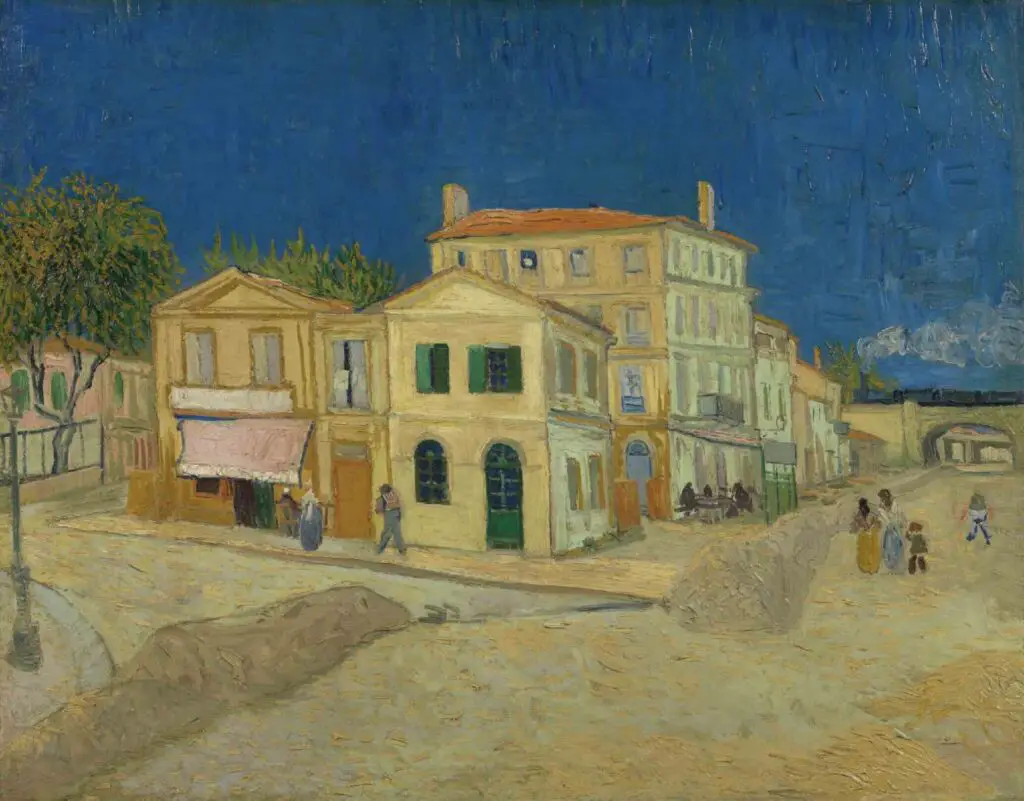
This painting is significant as it reflects Van Gogh’s desire to create an artist’s community in Arles, where he hoped to collaborate and work alongside artists like Paul Gauguin.
The yellow house symbolizes his dream of a harmonious and vibrant artistic environment, though personal conflicts would ultimately shatter this dream.
Green Wheat Field with Cypress (1889)
Green Wheat Field with Cypress, painted in 1889, is a powerful representation of Van Gogh’s emotional connection with the natural world. This painting features a cypress tree rising dramatically against a turbulent sky and a lush green wheat field in the foreground.
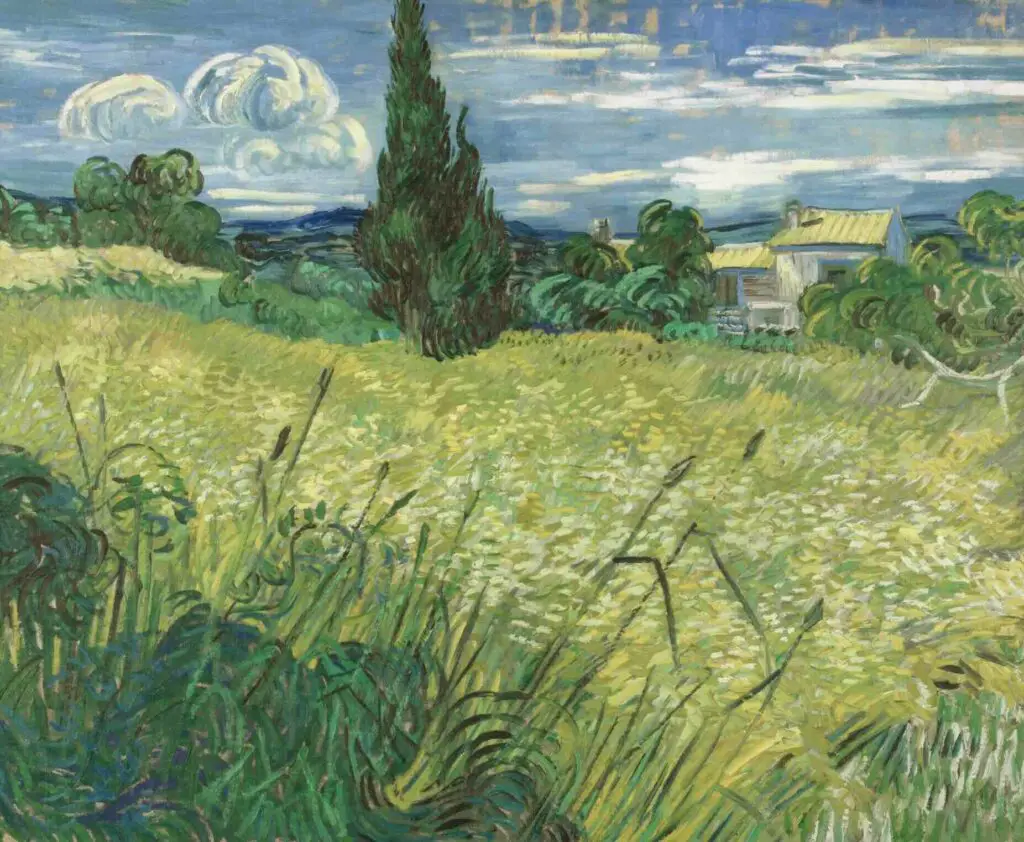
The significance of Green Wheat Field with Cypress lies in its ability to convey vitality and melancholy. The cypress tree, often associated with death and mourning in Mediterranean culture, symbolizes Van Gogh’s inner struggles.
Yet, the vibrant green of the wheat field suggests renewal and hope. It’s a poignant reflection of the artist’s complex emotional state and ability to find beauty and meaning in adversity.
Wheatfield with Crows (1890)
Wheatfield with Crows, painted in the final months of Van Gogh’s life in 1890, is a haunting and reflective work. It portrays a desolate wheat field with dark, swirling crows in the ominous sky above.
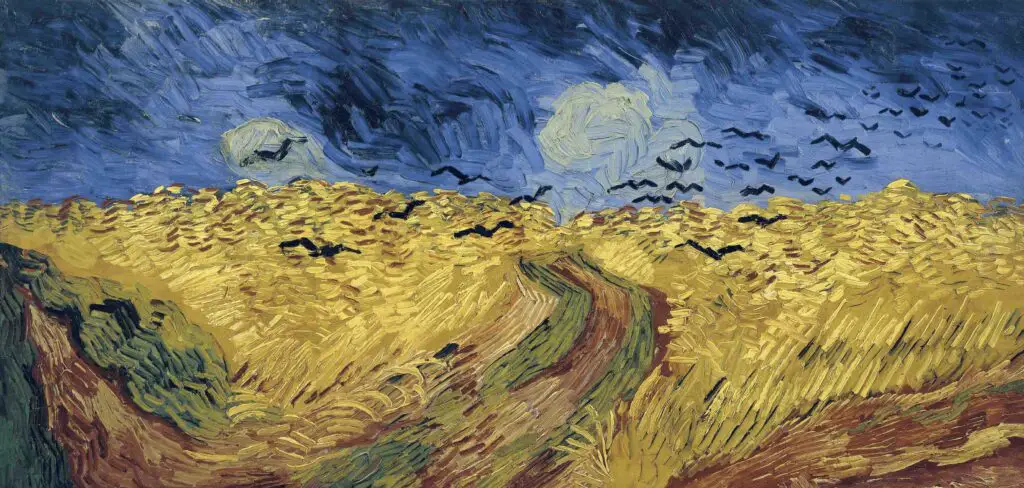
This painting is significant as it is often interpreted as a reflection of Van Gogh’s inner turmoil and impending mental crisis. The ominous atmosphere and the presence of the crows have led many art scholars to see it as a metaphor for his despair and sense of impending doom.
While it is a sad and sad work, it also showcases Van Gogh’s ability to use the landscape to express his deepest emotions.
Wheat Field with Cypresses (1889)
Wheat Field with Cypresses, painted in 1889, is another example of Van Gogh’s fascination with cypress trees and wheat fields. This painting is significant for its vibrant colors and bold brushwork to capture the essence of the Provençal landscape.
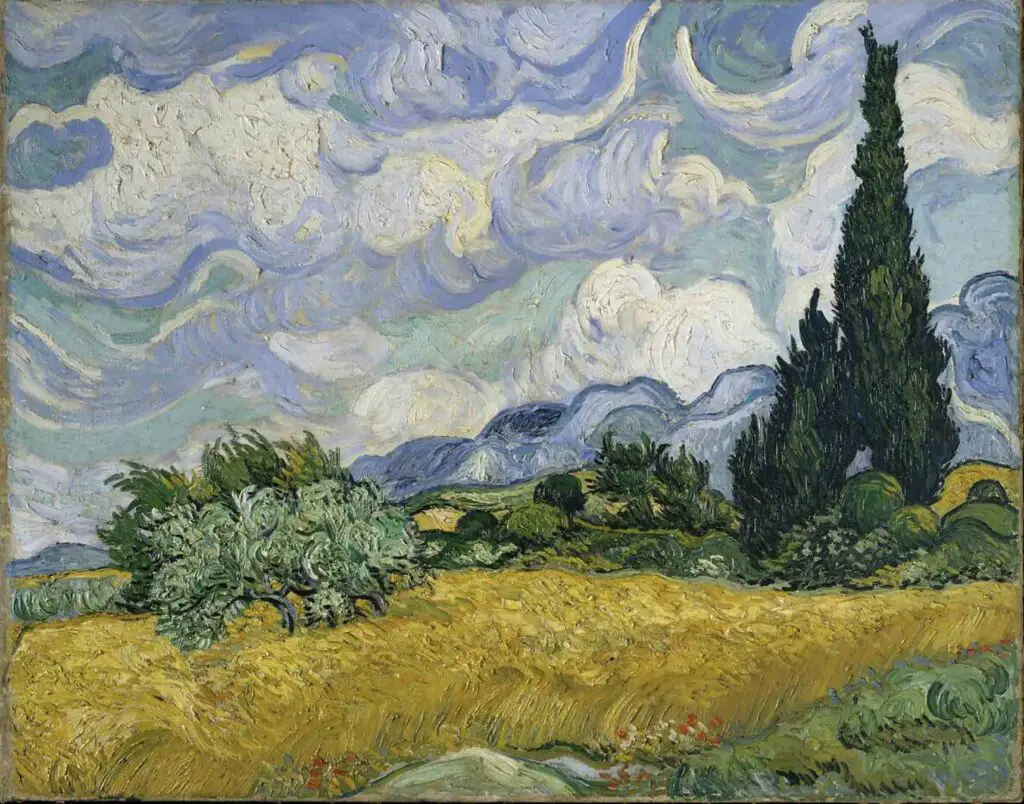
Van Gogh’s choice of subject matter reflects his love for the countryside around Saint-Rémy and his desire to convey its beauty to the world. The swirling patterns in the sky and the rhythmic lines of the cypress trees and wheat create a sense of movement and energy.
Wheat Field with Cypresses embodies Van Gogh’s ability to infuse nature with his emotional intensity, creating visually striking and emotionally charged landscapes.
View of Arles, Flowering Orchards (1889)
View of Arles, Flowering Orchards, painted in 1889, captures the beauty of the orchards in full bloom in the town of Arles. This painting is significant for celebrating spring’s fleeting beauty and the flowering trees’ vibrant colors.

Van Gogh’s vibrant colors, especially the blossoms’ radiant pinks and whites, convey a sense of joy and optimism. It reflects his belief in the transformative power of nature and the ability of the landscape to uplift the human spirit.
View of Arles, Flowering Orchards is a testament to Van Gogh’s ability to find solace and inspiration in the world around him, even during personal turmoil.
Olive Trees with Yellow Sky and Sun (1889)
Olive Trees with Yellow Sky and Sun, painted in 1889, is another fascinating depiction of olive trees in the Provençal landscape. The vivid yellow sky and the radiant sun dominate the composition, casting a warm and mystical light over the olive groves.
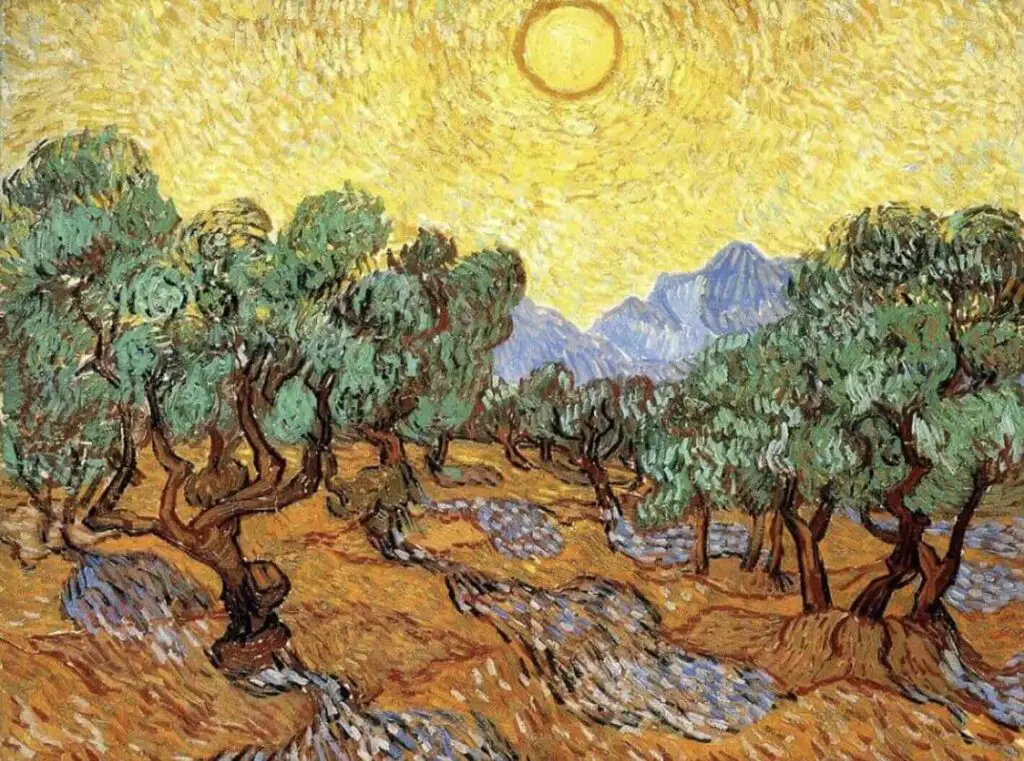
The significance of this painting lies in its spiritual resonance. Van Gogh often saw the sun as a symbol of life and hope, and here, it takes on a central role, illuminating the landscape and infusing it with a sense of divine presence.
Olive Trees with Yellow Sky and Sun is a testament to Van Gogh’s belief in the spiritual power of nature and his ability to convey that power through his art.
Farmhouse in Provence (1888)
Farmhouse in Provence, painted in 1888, depicts a rustic farmhouse nestled amidst wheat fields. This painting is significant for its portrayal of the simple and idyllic life of the rural countryside.
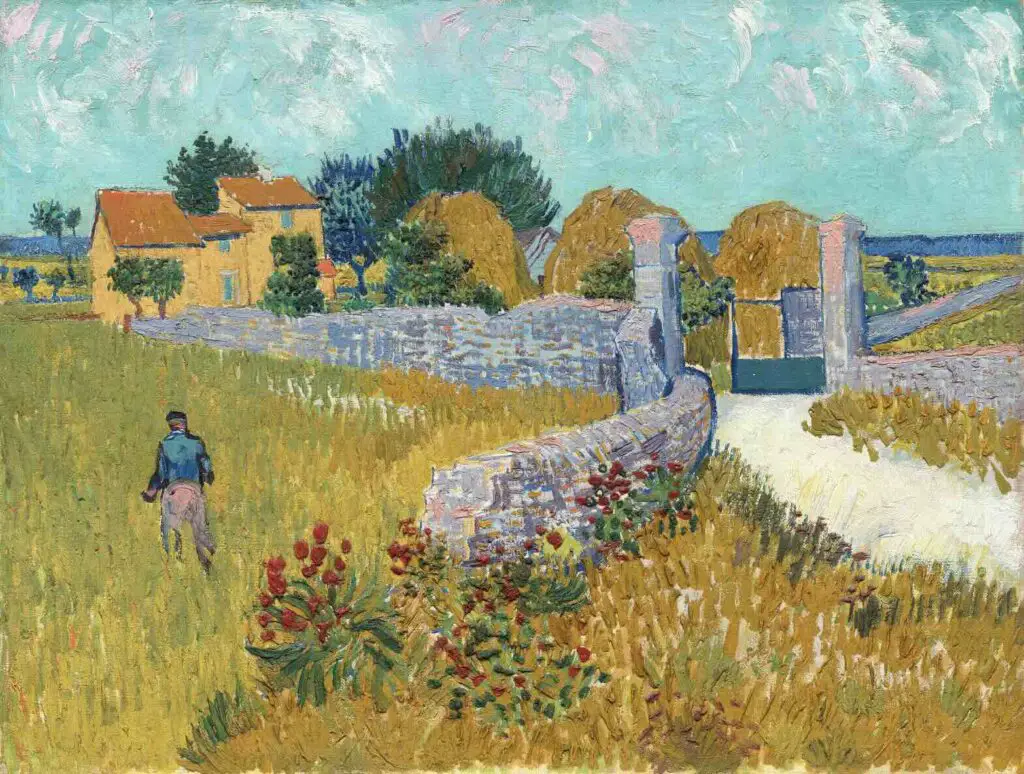
Van Gogh’s choice to focus on rural scenes reflects his admiration for the ordinary people and their connection to the land. The warm and earthy colors evoke a sense of nostalgia and tranquility, capturing the essence of rural life in Provence. Farmhouse in Provence serves as a reminder of Van Gogh’s desire to connect with the ordinary and find beauty in the everyday.
The Poet’s Garden (1888)
The Poet’s Garden, painted in 1888, is a charming portrayal of a garden in Arles. The vibrant flowers and lush greenery create a vivid and inviting scene.
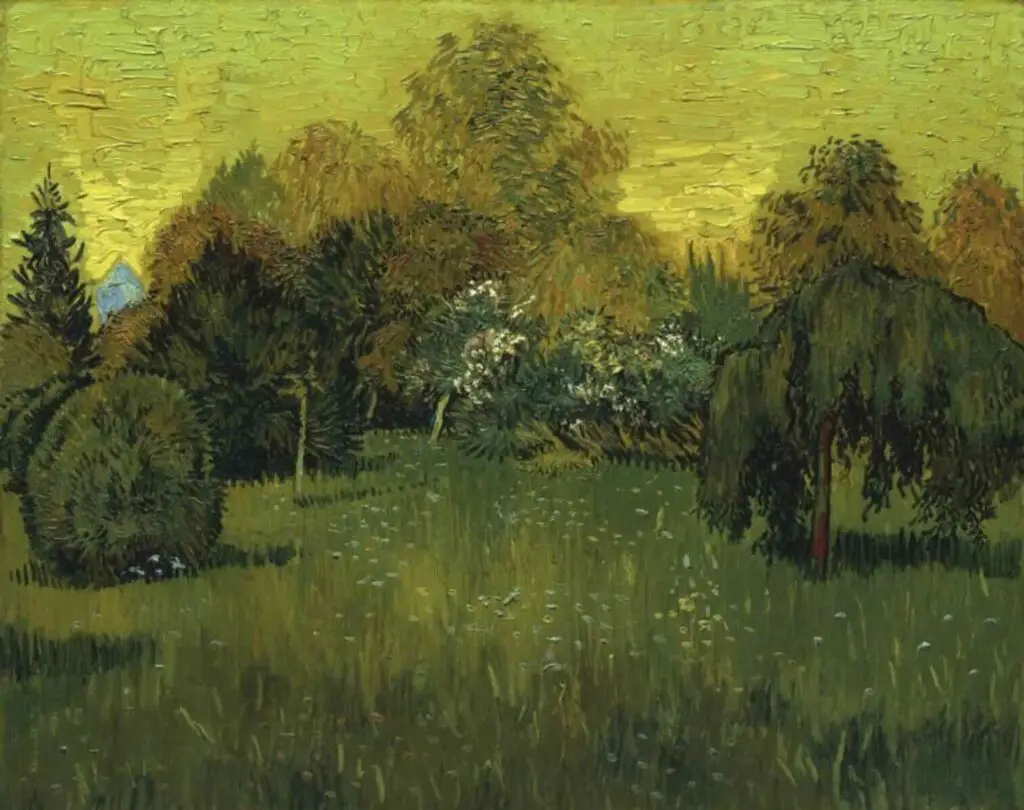
This painting is significant for its celebration of the beauty of the natural world. Van Gogh’s meticulous attention to detail and vibrant colors convey a sense of joy and appreciation for the garden’s splendor. The Poet’s Garden reflects Van Gogh’s belief in the restorative power of nature and his desire to share that beauty with others.
Entrance to the Public Gardens in Arles (1888)
Entrance to the Public Gardens in Arles, painted in 1888, depicts a picturesque garden scene in Arles. This painting is significant for portraying a tranquil and harmonious outdoor space.
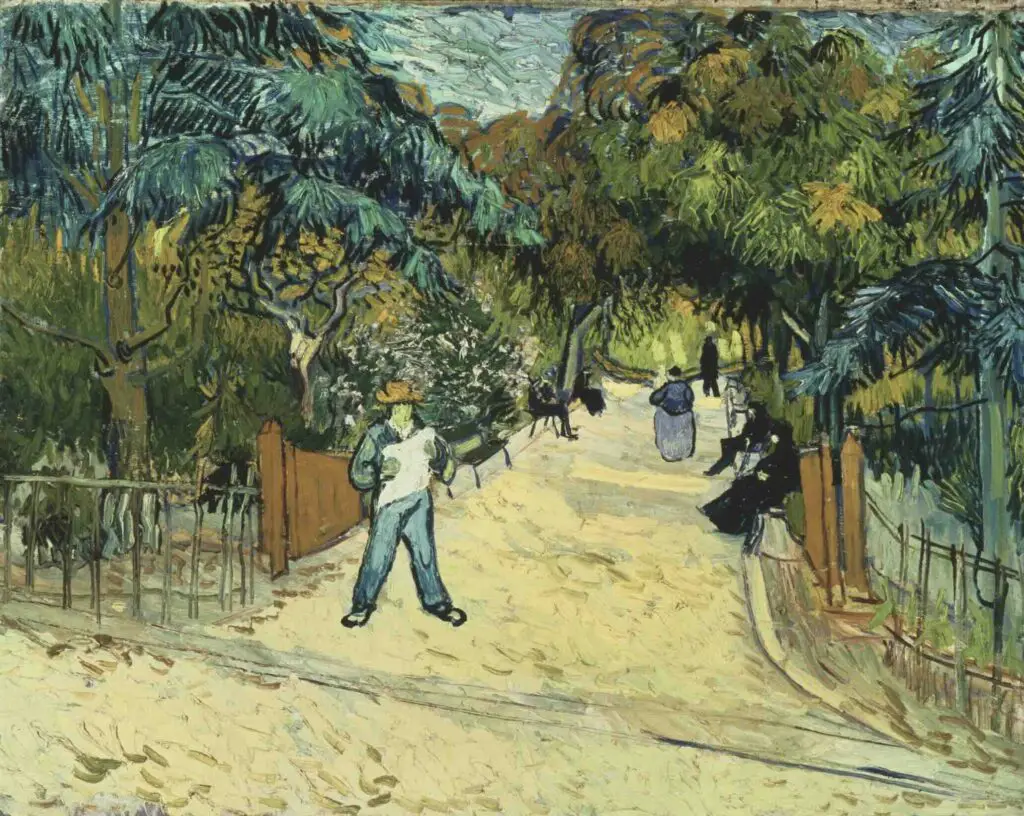
Van Gogh’s choice to paint the entrance to the public gardens reflects his fascination with the town’s landscapes and his desire to capture the beauty of everyday life.
The vibrant colors and inviting composition convey a sense of peace and serenity. Entrance to the Public Gardens in Arles is a testament to Van Gogh’s ability to find solace and inspiration in the ordinary.
Wheat Stacks with Reaper (1888)
Wheat Stacks with Reaper, painted in 1888, vividly portrays a reaper working in the fields. This painting is significant for celebrating the agricultural laborers and their connection to the land.
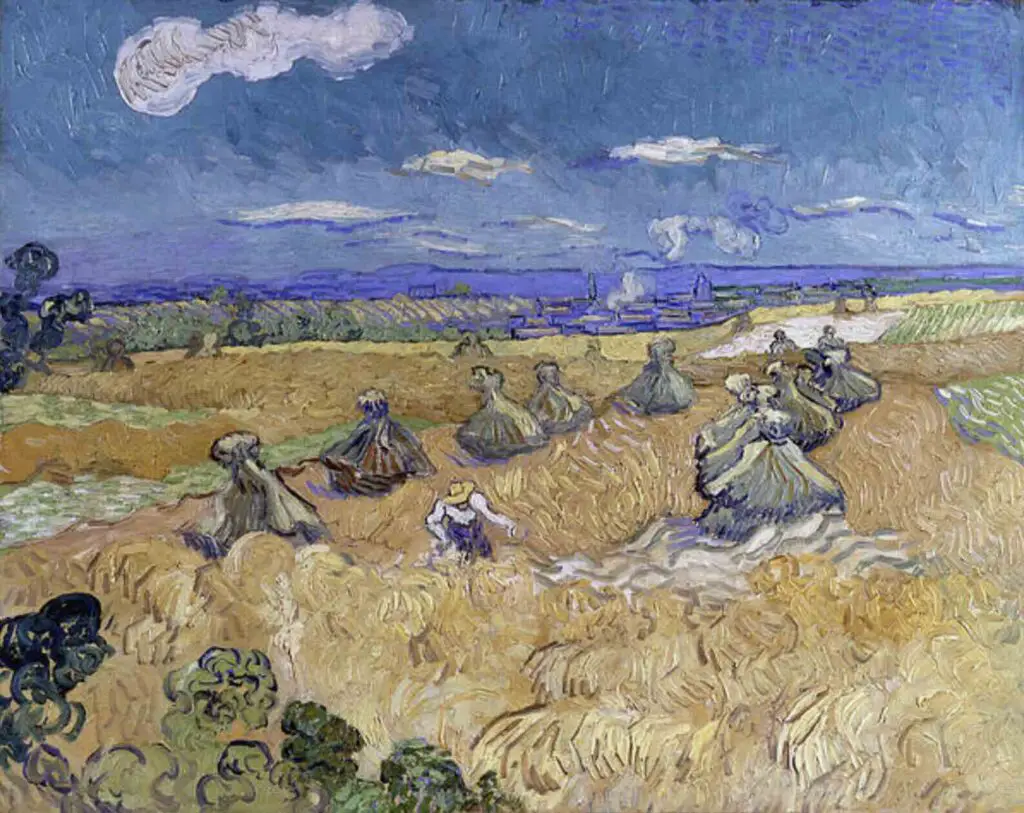
Van Gogh’s use of bold colors and dynamic composition conveys a sense of energy and vitality. The reaper’s movement and the towering wheat stacks create a sense of rhythm and harmony. Wheat Stacks with Reaper reflects Van Gogh’s admiration for the hardworking people who toiled in the fields to sustain their communities.
Willows at Sunset (1888)
Willows at Sunset, painted in 1888, captures the enchanting beauty of willow trees along the banks of the Rhône River at sunset. This painting is significant for portraying the play of light and shadow and its ability to convey a sense of tranquility.
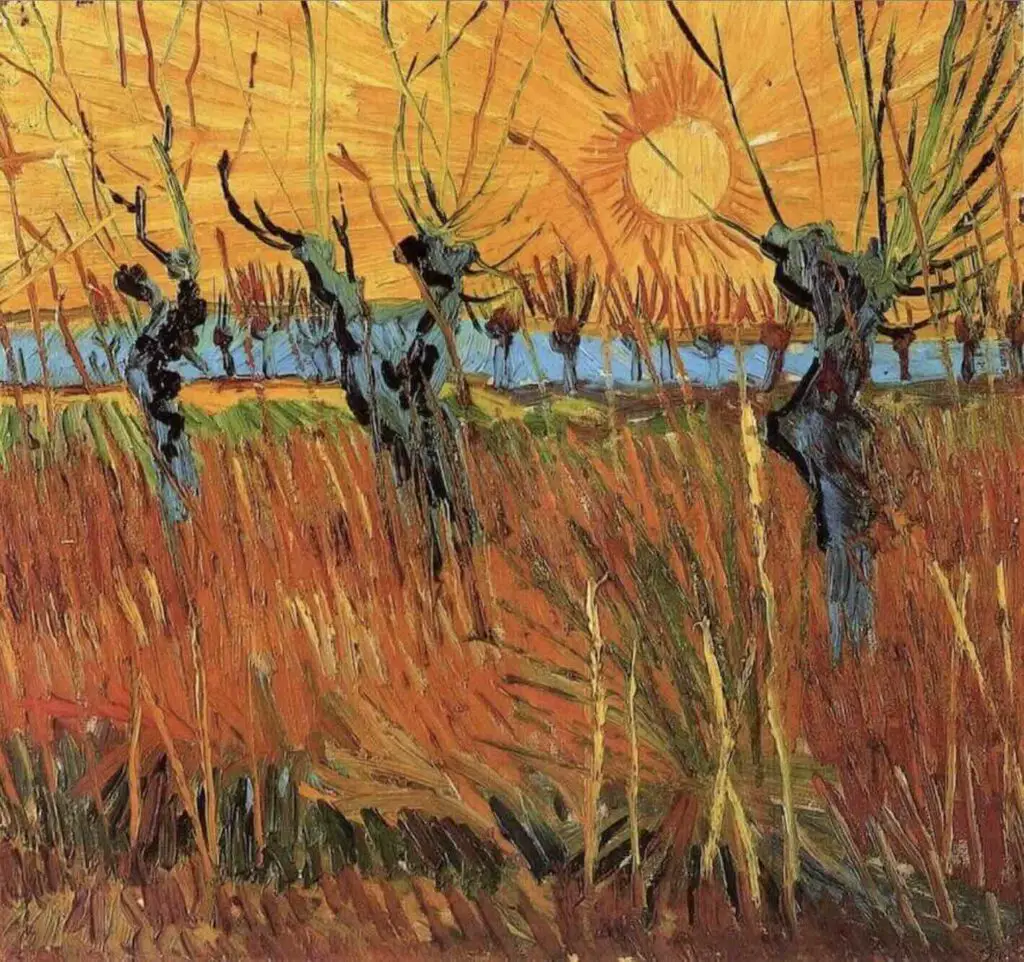
Van Gogh’s choice to focus on the willows and the riverbank reflects his fascination with the changing effects of light and nature’s ability to create moments of serene beauty. The warm hues of the sunset and the reflection in the water create a sense of calm and reflection.
Willows at Sunset showcases Van Gogh’s mastery of capturing the fleeting moments of beauty in the natural world.
The Langlois Bridge at Arles (1888)
The Langlois Bridge at Arles, painted in 1888, is a picturesque depiction of a drawbridge over the canal in Arles. This painting is significant for portraying the local infrastructure and its integration into the natural landscape.
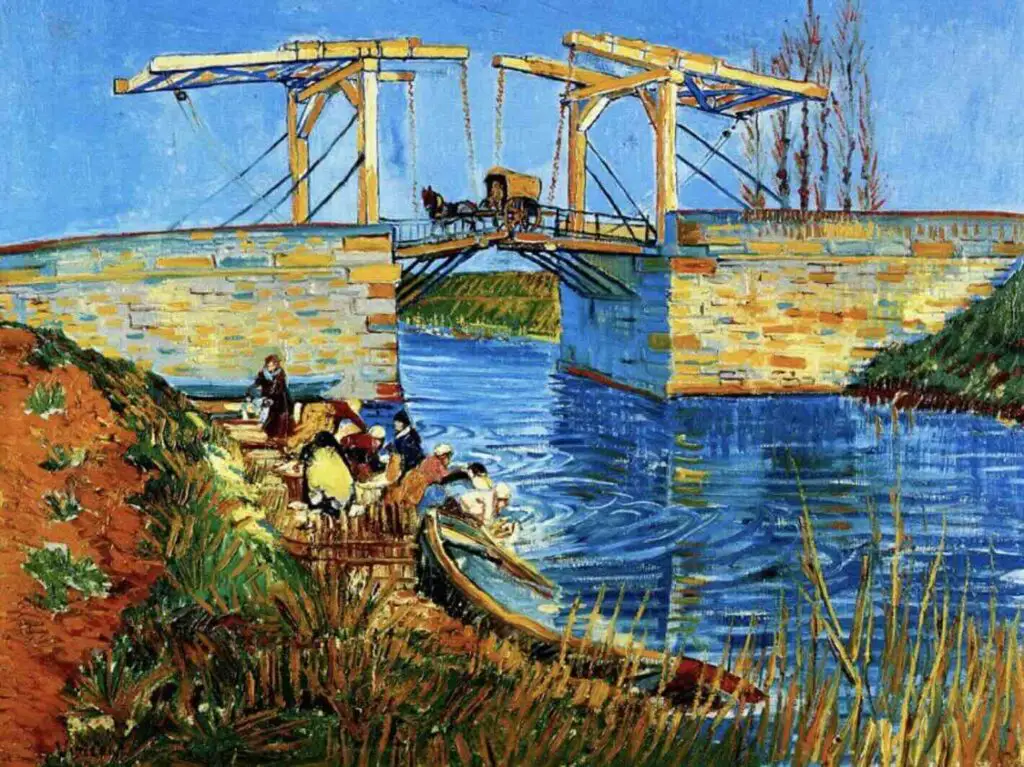
Van Gogh’s choice to paint the bridge reflects his fascination with the town’s architecture and his desire to capture the beauty of everyday scenes. The vibrant colors and the reflection in the water create a sense of harmony between the artificial and natural elements. The Langlois Bridge at Arles serves as a testament to Van G
Gogh’s ability to find beauty in the mundane and elevate it through his art.
The Church at Auvers (1890)
The Church at Auvers, painted in 1890, is a striking portrayal of the church in the town of Auvers-sur-Oise, where Van Gogh spent the final months of his life. This painting is significant for portraying the church as a towering and enigmatic presence against a turbulent sky.

The significance of this painting lies in its ability to convey a sense of spirituality and emotional intensity. Van Gogh’s bold colors and dramatic composition create a sense of awe and reverence.
The Church at Auvers reflects Van Gogh’s deep emotional connection to the landscape and his desire to convey the spiritual essence he found in the world around him.
A Meadow in the Mountains: Le Mas de Saint-Paul (1889)
A Meadow in the Mountains: Le Mas de Saint-Paul, painted in 1889, is a breathtaking depiction of a meadow surrounded by mountains. This painting is significant for portraying the Provençal landscape as a place of tranquility and beauty.
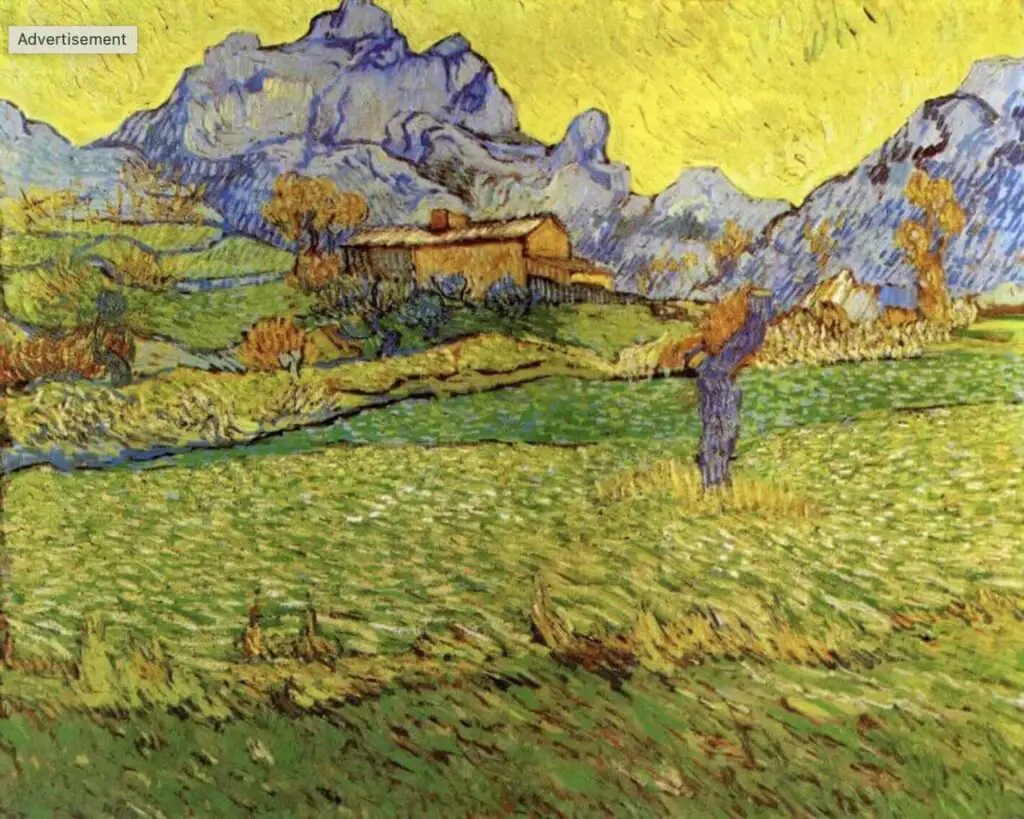
Van Gogh’s choice to paint this scene reflects his love for the countryside around Saint-Rémy and his desire to capture its serene beauty. The vibrant colors and the play of light on the mountains and meadows create a sense of harmony and serenity.
A Meadow in the Mountains showcases Van Gogh’s ability to find solace and inspiration in the natural world, even during moments of personal struggle.
Woman Walking Under the Trees (L’Oliver) (1889)
Woman Walking Under the Trees (L’Oliver), painted in 1889, is a graceful portrayal of a woman walking beneath the olive trees. This painting is significant for celebrating the harmony between humanity and nature.
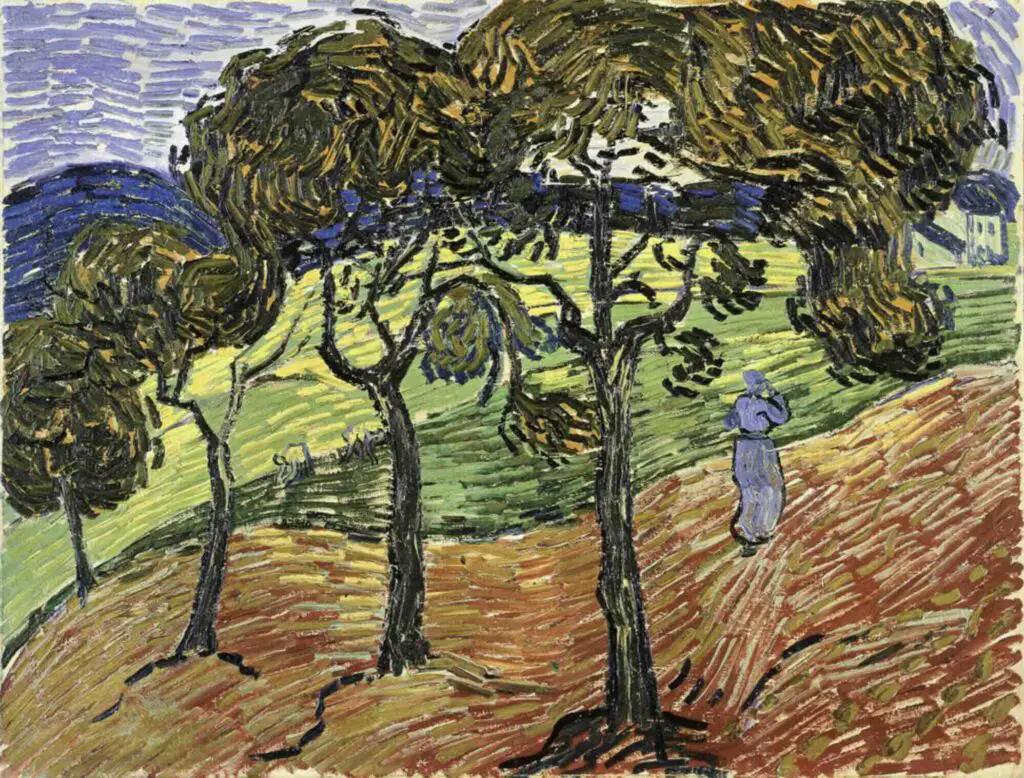
Van Gogh’s choice to depict a woman in this scene reflects his belief in the connection between people and the natural world. The dappled light filtering through the olive branches creates a sense of serenity and contemplation.
Woman Walking Under the Trees embodies Van Gogh’s ability to convey a sense of tranquility and unity in his landscape paintings.
Olive Grove (1889)
Olive Grove, painted in 1889, is another example of Van Gogh’s fascination with olive trees and the Provençal landscape. This painting is significant for its portrayal of the vitality and beauty of the olive groves.

Van Gogh’s bold colors and energetic brushwork convey a sense of vibrancy and life. The twisting trunks of the olive trees and the lush foliage create a sense of movement and vitality. Olive Grove reflects Van Gogh’s ability to infuse his landscapes with a sense of energy and emotion, making them come alive on the canvas.
The Road Menders (1889)
The Road Menders, painted in 1889, depicts a group of laborers repairing a road in the Provençal countryside. This painting is significant for its portrayal of the dignity and camaraderie of the working class.
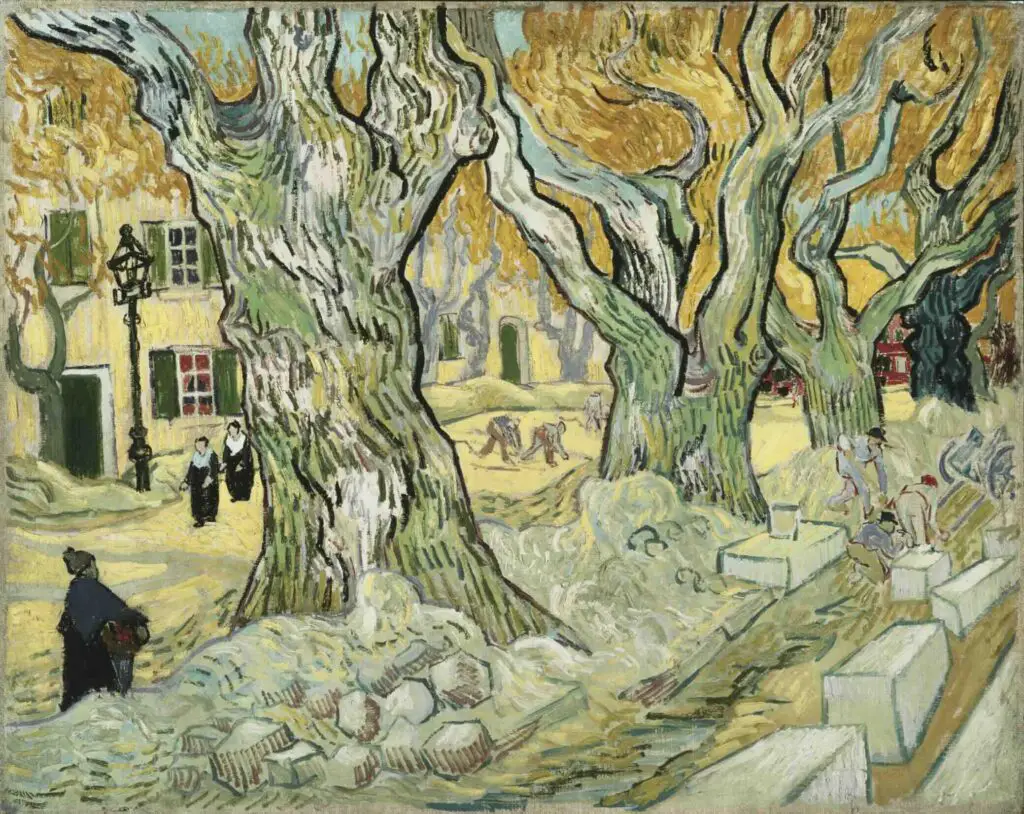
Van Gogh’s choice to focus on the road menders reflects his admiration for ordinary people and their contributions to society. The warm and earthy colors and the solid and purposeful figures convey a sense of unity and purpose.
The Road Menders serves as a reminder of Van Gogh’s empathy for the working class and his desire to capture their everyday lives.
View of Paris from Montmartre (1886)
View of Paris from Montmartre, painted in 1886, is a cityscape that offers a different perspective from Van Gogh’s more famous landscapes. This painting is significant for portraying the urban landscape and its integration into the natural world.
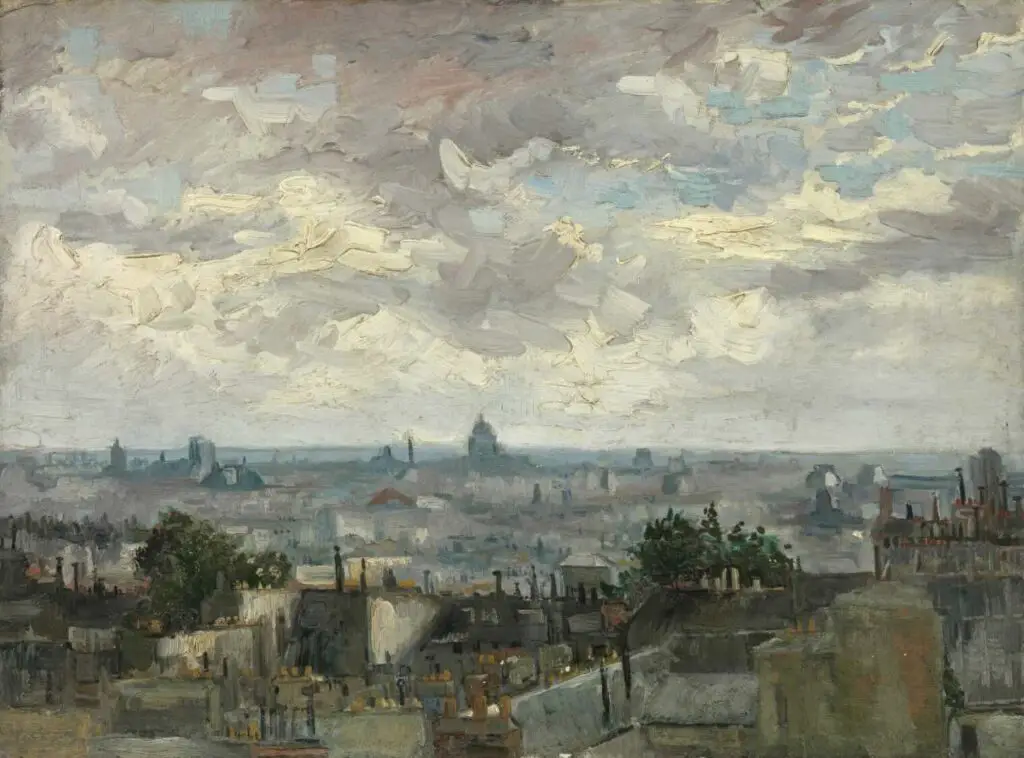
Van Gogh’s choice to paint this scene reflects his fascination with Paris and its bustling streets. The use of vibrant colors and the sweeping view of the city create a sense of dynamism and energy.
View of Paris from Montmartre showcases Van Gogh’s versatility as an artist and his ability to find beauty in rural and urban landscapes.
Vincent van Gogh’s landscape paintings are a testament to his deep emotional connection with the natural world and his ability to convey his innermost thoughts and feelings through art.
Each of the landscapes mentioned here is significant for its unique qualities, whether it’s the emotional intensity of The Starry Night, the spiritual resonance of Olive Trees with Yellow Sky and Sun, or the celebration of everyday life in The Road Menders. Van Gogh’s landscapes continue to inspire and move audiences worldwide, reminding us of the power of art to capture the beauty and complexity of the human experience.
Anita Louise Art is dedicated to art education, great artists, and inspiring others to find and create their art. We love art that uplifts and inspires. #ArtToMakeYouSmile! #ArtToMakeYouHappy!
If you are interested to see any of my art, you can find out more by clicking here. If you are interested in what inspires me and my paintings, you can discover more by clicking here.
We have a free newsletter and would love you to be part of our community; you can subscribe to the newsletter by clicking here. If you have any questions, I would be happy to talk to you anytime. You can reach me, Anita, by clicking here.
Subscribe to our Anita Louise Art YouTube Channel with great videos and information by clicking here.
Join us for our podcast “5 Minutes With Art.” Spend just 5 minutes a week with us to discover and learn about great art and artists. You can find out more about our podcast by clicking here.
Related Questions
Which Ear Did Van Gogh Cut Off Left Or Right? And Other Facts
Vincent Van Gogh cut off his left ear; he painted several paintings of himself with the bandaged ear. The events leading up to the ear cutting were because of artistic disagreements with the artist Paul Gauguin. Cutting off his left ear made the local newspaper’s front page and set off a chain of events that would change Vincent Van Gogh’s life forever.
By clicking here, you can discover more by reading Which Ear Did Van Gogh Cut Off Left Or Right? And Other Facts.
Why Did Vincent Van Gogh Commit Suicide?
Vincent Van Gogh had a mental illness; many believe he was manic-depressive. He was also sad and lonely and felt a huge financial burden. He committed himself to the mental hospital for treatment, but all this made it very difficult for him to do what he loved most, which was to paint.
By clicking here, you can learn more by reading Why Did Vincent Van Gogh Commit Suicide?
Why Are Vincent Van Gogh’s Paintings So Valuable?
Vincent van Gogh was an extremely prolific artist who painted over 900 works of art during his short lifetime. His work is appealing, and his use of colors and brushstrokes help make his art genuinely unique. He inspired many art movements and artists, and Van Gogh left us a legacy of his art and his letters and thoughts.
By clicking here, you can discover more by reading Why Are Vincent Van Gogh’s Paintings So Valuable?

